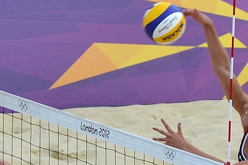“One of the most important concepts in the physical therapy world is proximal and/or distal stability. We rarely look at only the area of injury, but rather the whole body.”
Volleyball REHABILITATION
Shoulder Health in Volleyball Players Volleyball, like many overhead sports, has a high incidence of overuse injuries of the shoulder. Sports such as volleyball demand a high level of repetitive overhead motion which places the shoulder in a vulnerable position for injury. By design, the shoulder joint has maximum mobility though often at the cost of stability. Without an adequate combination of strength and endurance, this increased mobility places it at higher risk for injury. Some of the most common shoulder injuries include rotator cuff tendonitis, bicep tendonitis, SLAP lesions, impingement syndrome, or traumatic Bankart lesions secondary to dislocation. One of the best ways that volleyball players can combat these injuries is to maintain good shoulder health throughout participation in the sport. Below, I discuss some keys to achieving this “good shoulder health”
Proper mechanics
First you want to ensure that you are using the proper mechanics during your arm swing. This will increase your chances of success by limiting abnormal stresses placed on commonly injured tissues. To assess this, you can take video of your arm swing and go over this with your coach or other knowledgeable party. Keep in mind that every arm swing does not have to look the same. If you are not currently having pain or restriction in your arm swing, this may not be imperative to your program and may be better left alone. This may also be more important to assess in a player new to the sport.
Dynamic Warmup
A dynamic warm-up should be designed to move, stretch, and/or activate the tissues and joints that will be most used during the activity to follow. This may vary and does not have to be the same set of movements for every athlete. More examples below in the video section.
Rotator Cuff Health
During the typical volleyball arm swing, the rotator cuff plays a crucial role in both the cocking phase and controlled swinging phase of the movement. Without a stable foundation provided by your surrounding shoulder blade muscles, the rotator cuff’s already large role will be that much greater. It is imperative that you have the strength and endurance in both of these areas to withstand the forces placed on your shoulder during highly repetitive overhead motions. Stay tuned for a video series sharing some of my favorite exercises to achieve this.
Core Strength
One of the most important concepts in the physical therapy world is proximal and/or distal stability. We rarely look at only the area of injury, but rather the whole body. This concept means that joints above, below, or near the joint of interest need to be stable/mobile enough for the joint of interest to function optimally. The volleyball arm swing requires a significant contribution from the thoracic spine (upper back) for rotation and the core for control and power during the swing. If any of these areas is lacking, the shoulder is again required to work overtime. So, if you are doing everything right with 1,2, and 3 of these key points and still find yourself in trouble, look at the areas surrounding your shoulder!




